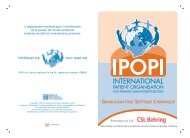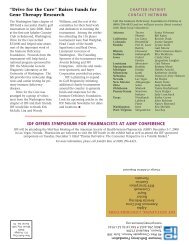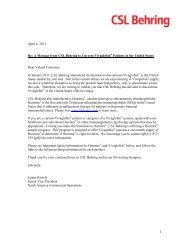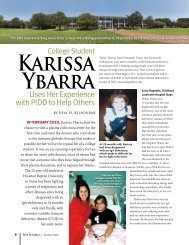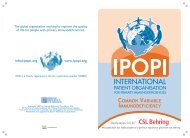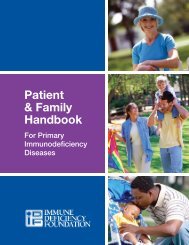Stem Cell Therapy and Gene Therapy
Stem Cell Therapy and Gene Therapy
Stem Cell Therapy and Gene Therapy
You also want an ePaper? Increase the reach of your titles
YUMPU automatically turns print PDFs into web optimized ePapers that Google loves.
<strong>Stem</strong> <strong>Cell</strong> <strong>Therapy</strong> <strong>and</strong> <strong>Gene</strong> <strong>Therapy</strong><br />
Results of HSCT<br />
HSCT between HLA matched siblings has been<br />
successfully employed in the treatment of primary<br />
immunodeficiency diseases since 1968. The first child<br />
to receive a transplant (a patient with X-SCID) is still<br />
alive, healthy <strong>and</strong> has a family of his own. This case<br />
suggests that, as best as can be determined, the graft is<br />
very long lasting <strong>and</strong> appears to be permanent.<br />
In the case of infants with SCID, HSCT involving a<br />
matched marrow has minimal graft versus host disease<br />
risk <strong>and</strong> is associated with an overall success rate of as<br />
high as 90%. Results of HSCT from unrelated donors<br />
from a haploidentical parent are not as good, yet<br />
approximately 60-80% of the infants survive <strong>and</strong><br />
demonstrate robust T-cell reconstitution.<br />
The chance of survival depends on the health of the<br />
patient at the time of the transplant. If the patient is in<br />
relatively good health, free from infection at the time of<br />
the transplantation <strong>and</strong> does not have lung damage<br />
from previous infections, the outlook is very good.<br />
Because of this, survival is very good (>90%) in infants<br />
with SCID who receive HSCT within 3-4 months of age,<br />
even when the donor is not a family match. This<br />
emphasizes the importance of early recognition of SCID,<br />
<strong>and</strong> the benefit of newborn screening for this disease,<br />
that is BEFORE the patient has a serious infection.<br />
While reconstitution of the number <strong>and</strong> function of T-<br />
lymphocytes is the rule after HSCT for SCID,<br />
normalization of antibody production occurs in some,<br />
but not all, patients. Reconstitution of antibody<br />
production after HSCT for SCID depends on the specific<br />
form of SCID, on the type of donor (matched vs.<br />
haploidentical) <strong>and</strong> on the use of chemotherapy as part<br />
of the preparative regimen before the HSCT. If antibody<br />
production is not reconstituted after HSCT, patients will<br />
require Ig replacement therapy indefinitely to help<br />
protect them from infection. Even if replacement therapy<br />
is required, these patients usually enjoy a good quality<br />
of life after transplant.<br />
HSCT is also an effective form of treatment for other<br />
forms of primary immunodeficiency diseases, including<br />
WAS, IPEX, HLH), XLP, X-linked hyper-IgM (also known<br />
as CD40 lig<strong>and</strong> deficiency), CGD <strong>and</strong> other primary<br />
immunodeficiency diseases.<br />
In most of these conditions, conditioning with<br />
chemotherapy is required before the transplant to allow<br />
engraftment of donor-derived stem cells, even when the<br />
donor is a matched sibling. The success rate after HSCT<br />
from an unrelated donor in these cases is nearly as<br />
good (70-80% survival) as using a matched sibling for<br />
the donor. Here again, the initial health of the patient is<br />
extremely important <strong>and</strong> the best survival rates are in<br />
children who are transplanted under the age of 5, who<br />
are relatively free of infections <strong>and</strong> who do not have preexisting<br />
lung or liver damage.<br />
Mixed chimerism (that is persistence of the patient’s<br />
immune cells along with donor-derived white blood<br />
cells) after HSCT is sufficient to cure the disease in<br />
many of these disorders (IPEX, HLH, XLP, X-linked<br />
hyper-IgM, CGD), <strong>and</strong> this may allow doctors to use less<br />
intense chemotherapy, thus also reducing the risk of<br />
related toxicity. In boys with WAS, mixed chimerism is<br />
associated with a higher risk of complications<br />
(autoimmunity, persistence of low platelets) <strong>and</strong> more<br />
intense chemotherapy regimens are typically used for<br />
this disease.<br />
HSCT is not always indicated in patients with CD40<br />
lig<strong>and</strong> deficiency <strong>and</strong> CGD, as many of these patients<br />
do well on medical management. The risks <strong>and</strong> benefits<br />
of the procedure must always be carefully weighed.<br />
It must be noted that HSCT from a haploidentical parent<br />
is not as successful in primary immunodeficiency<br />
diseases other than SCID <strong>and</strong> is typically reserved to<br />
very severe cases that cannot be safely managed<br />
otherwise. Again the risks <strong>and</strong> benefits must be carefully<br />
addressed.<br />
157 | IDF Patient & Family H<strong>and</strong>book








